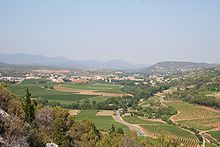Saint-Chinian (wine region)
The Saint-Chinian wine-growing region lies between the Minervois (east) and Faugères (south-west) appellations in the French wine-growing region of Languedoc .
history
In 794 the Benedictine monk Anhan founded a monastery on the left bank of the Vernazobres. The monastery was soon named Sanch Ahan and was finally renamed Saint-Chinian in 1102. Despite the poor relationship between the monastery and the rural population, a flourishing viticulture was able to develop. The wine was famous in the wider area as early as the 14th century . Nevertheless, the constantly smoldering conflict with the monastery represented a significant obstacle in the development of the region. Important sources of income were therefore the manufacture of cloths and the settlement of several tanneries until the 19th century. However, due to severe floods in 1875, these industries were destroyed and no longer rebuilt. A concentration on viticulture followed. Since the area was struck by the phylloxera disaster very late , it was possible to prepare for the necessary changes so that, unlike in other regions, viticulture did not come to a standstill.
Appellations
Today viticulture is an important source of income for the region. Since May 5, 1982, the area has had the status of an Appellation d'Origine Contrôlée (AOC for short). The vineyards cover around 2,800 hectares of planted vineyards in 20 communities in the Hérault department . Geographically, the area is divided into the northern, higher part with slate soils and the southern part with clay and limestone soils. The sour slate soils tend to produce more fruity and accessible wines , while the clay and limestone soils produce more structured and tannic wines. For 90 days a year there is practically no rain, so the vines are very deeply rooted in order to be able to absorb sufficient moisture.
The annual production amounts to approx. 135,000 hectoliters of wine, which is divided into 90% red wine , 9.5% rosé wine and 0.5% white wine . 9 wine cooperatives operate in the area, representing two thirds of production. The rest is shared by 100 self-marketing winemakers. The most important export countries are Belgium (9360 hectoliters), Denmark (5,780 hectoliters) and Canada (4,850 hectoliters). Since 2004, 2 communal, subordinate wine-growing areas have been defined within this regional appellation:
- Saint-Chinian Berlou
- Saint-Chinian Roquebrun
Grape varieties
In the regional appellation are red and pink from the vine Grenache (min. 20%), Lledoner Pelut (min. 20%), Mourvèdre (min. 10%) and Syrah (min. 10%) produced. The common, minimum proportion of these four varieties has been 60% since 1998. In addition to the four varieties, the varieties Carignan (max. 40%) and / or Cinsault (max. 30%) are permitted. The minimum alcohol content is 11% by volume. A large part of the rosé wine should be obtained using the Saignée method. While the red wines can be stored for 5–8 years and should be enjoyed at 15–16 ° C, it is advisable to drink the rosé wines after 1–2 years of storage at 8–10 ° C.
The appellation Coteaux du Languedoc was valid for the white wine until 2004 . Since then, white wines have also been available under the appellation name Saint-Chinian. Approved grape varieties are the main grape varieties Grenache Blanc (proportion min. 30%), Marsanne blanche , Roussanne and Vermentino . The wine consists of at least two grape varieties, whereby the maximum proportion of one variety must not exceed 70%. In addition, small portions of the Bourboulenc , Carignan Blanc , Clairette Blanche and Macabeo varieties are allowed.
Approved municipalities
Assignan , Babeau-Bouldoux , Berlou , Causses-et-Veyran , Cazedarnes , Cébazan , Cessenon , Creissan , Cruzy , Ferrières-Poussarou , Murviel-les-Beziers , Pierrerue , Prades-sur-Vernazobre , Puisserguier , Quarante , Roquebrun , Saint- Chinian , Saint-Nazaire-de-Ladarez , Vieussan and Villespassans .
literature
- Jancis Robinson : The Oxford Wine Lexicon . 2nd Edition. Hallwag , Munich 2003, ISBN 3-7742-0914-6 (886 pages, English: The Oxford companion to wine . Translated by Wolfgang Kissel).
- Pierre Galet : Cépages et Vignobles de France . Lavoisier Publishing House, Paris 2004, ISBN 2-7430-0585-8 .
- Benoît France: Grand Atlas des Vignobles de France . Éditions SOLAR publishing house, Paris 2002, ISBN 2-263-03242-8 .
